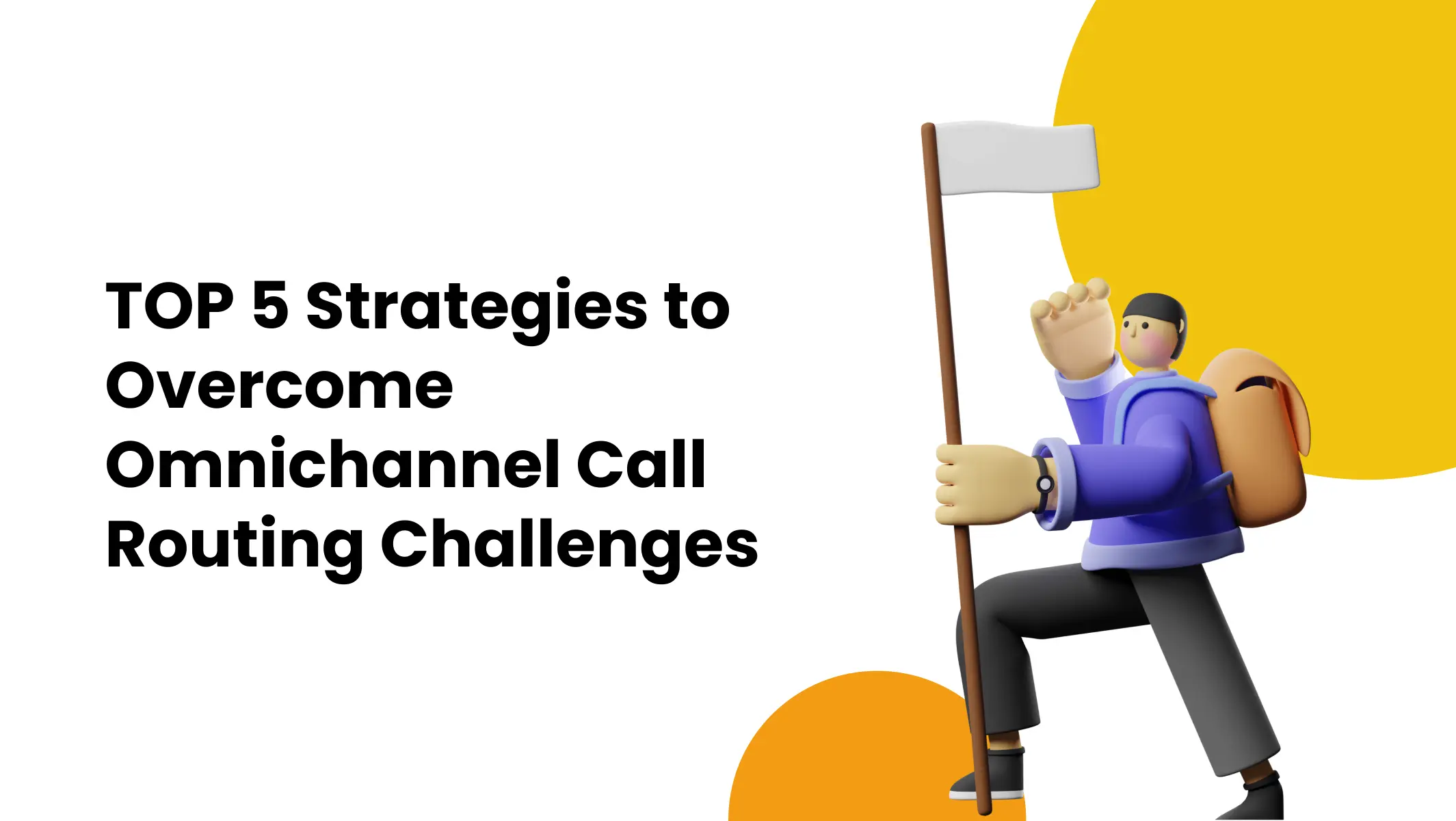Imagine a customer journey riddled with dead ends and frustrating hold times. This, unfortunately, is the reality for many businesses struggling with omnichannel call routing. These days, when customers seamlessly switch between phone calls, emails, and social media, a powerful call routing system is no longer a luxury; it’s essential. According to Deloitte, four in five companies have activated a channel steering strategy that deliberately guides customers to the most effective channel for their inquiry.
This guide equips you with the top five strategies for conquering omnichannel call routing challenges and ensuring your customers have a seamless experience worthy of their loyalty.
Key Challenges in Omnichannel Call Routing
Before diving into solutions, let’s acknowledge the roadblocks that can trip up even the most seasoned call-routing strategists:

Integration Complexity:
Juggling multiple systems for different channels like phone, email, and chat can be a nightmare. Inconsistent data flow and clunky integrations create frustrating silos that hinder smooth call routing.
Inconsistency of Customer Experience:
Customers expect a unified journey across channels. A disjointed experience, where a customer has to repeat their story on every call, often leaves a bad taste in their mouth and can damage your brand reputation.
Skill and Needs Mismatch:
Not all agents are created equal. Matching customer needs with the most qualified agent requires a sophisticated system that considers agent skills, experience, and language proficiency.
Real-time Performance Monitoring:
Without real-time insights into call volume, wait times, and agent performance, you’re essentially flying blind. Measuring and monitoring performance is crucial for identifying bottlenecks and optimizing your call routing strategy.
Scalability and Flexibility:
Your business needs are dynamic. A rigid call routing system that can’t adapt to growth or changing customer demands will quickly become a hindrance.
1. Embrace UCaaS for Omnichannel Call Routing
The answer to many of these challenges lies in a new solution: Unified Communications as a Service (UCaaS). UCaaS platforms like CloudCall offer omnichannel contact center software for all your communication needs. Imagine a single platform smoothly integrating phone calls, emails, chats, and more. This translates to:
Easy Integration:
CloudCall seamlessly integrates with existing business tools like your CRM, eliminating the need for multiple logins and data silos.
Numerous Features:
UCaaS platforms like CloudCall offer a variety of features specifically designed to streamline omnichannel call routing. These include skills-based routing, dynamic call distribution, and real-time analytics dashboards.

2. Implement Advanced Skill-Based Routing
Gone are the days of random call distribution. Skill-based routing ensures that customers connect with the most qualified agent for their specific needs. Here’s how CloudCall helps you achieve this:
Automated Call Distribution (ACD):
ACD routes calls based on pre-defined criteria like language, department, or urgency. Imagine a customer calling with a billing issue. ACD intelligently routes their call to a billing specialist, ensuring a faster resolution.
3. Route Calls to an Available Agent Using Real-Time Analytics and Reporting

Analytics Tools
CloudCall equips you with a comprehensive suite of analytics tools, providing a real-time window into your call center’s performance. This data empowers you to make informed decisions about call routing strategies, agent scheduling, and overall customer experience optimization. Let’s dive into some key functionalities within CloudCall’s analytics dashboard:
- Interactive Dashboards: CloudCall boasts user-friendly, interactive dashboards that provide a visual overview of key metrics. These dashboards are customizable, allowing you to tailor them to your specific needs and priorities.
- Real-Time Monitoring: Gaining real-time insights into call volume, wait times, agent activity, and more, is extremely important. CloudCall allows you to address potential bottlenecks and ensure a smooth call flow.
- Historical Data Analysis: CloudCall doesn’t just focus on the present; it empowers you to analyze historical data to identify trends and patterns. This historical analysis helps you forecast future call volume and plan staffing accordingly.
KPIs to Track
Effective call routing hinges on identifying and monitoring the right Key Performance Indicators (KPIs). Here are some crucial KPIs CloudCall helps you track, along with best practices for maximizing their impact:
- First Call Resolution (FCR): This metric measures the percentage of calls resolved on the first interaction. A high FCR indicates efficient call routing and minimizes customer frustration from being transferred repeatedly.
- Best Practices: Leveraging skills-based routing and ensuring agents have the necessary resources to resolve inquiries effectively on the first call.
- Average Handle Time (AHT): This metric measures the average time an agent spends handling a call. While a lower AHT might seem desirable, it shouldn’t come at the expense of quality. Aim for a balance between efficiency and providing thorough customer service.
- Best Practices: Analyze call recordings and identify areas for agent training to address repetitive questions or streamline troubleshooting processes.
- Customer Satisfaction (CSAT) Scores: CSAT scores gauge customer sentiment regarding their experience with your call center. High CSAT scores indicate effective call routing, connecting customers with the right agents who can resolve their issues quickly and efficiently.
- Best Practices: Implementing post-call surveys and actively collecting customer feedback to identify areas for improvement in your call routing strategy.
Call Reporting
CloudCall provides comprehensive call reports, empowering you to analyze data by agent, department, call type, and more. Here’s how to unlock the full potential of call reporting:
- Identify Peak Call Hours: Analyze call volume trends and identify peak hours. This data helps you optimize agent scheduling to ensure adequate staffing during high-volume periods and minimize customer wait times.
- Analyze Abandonment Rates: Track the number of calls abandoned before connecting with an agent. High abandonment rates indicate customer frustration with long wait times. Utilize real-time data to trigger automated callbacks or adjust staffing levels during peak hours.
- Pinpoint Skills Gaps: Reporting can reveal which types of calls take longer to resolve or require transfers. This data can help you identify skills gaps within your agent pool and tailor training programs to address specific customer needs.
Agent Status
CloudCall empowers agents to update their status in real-time (available, on a call, on break). This ensures calls are routed only to available agents, minimizing customer wait times and frustration. Here’s how agent status management benefits your call-routing strategy:
- Accurate Availability Data: Real-time agent status ensures calls are never routed to unavailable agents, eliminating the need for customers to repeat their inquiries.
- Skill-Based Availability: CloudCall allows agents to indicate their availability to handle specific types of calls. This empowers you to route calls to agents with the most relevant expertise for a faster resolution.
4. AI and Machine Learning for Intelligent Call Routing
The future of call routing is intelligent and powered by AI. Here’s what lies ahead:
Interactive Voice Response (IVR):
AI-powered IVRs go beyond basic menus. They understand natural language and can even guide customers toward self-service solutions through voice prompts. Imagine an IVR that understands a customer saying, “billing issue,” and automatically directs them to the billing department.
5. Centralize Call Routing Management and Automation
Managing a call routing system shouldn’t feel like a highwire juggling act. CloudCall offers tools for centralized management and automation:
CRM Integrations:
CloudCall seamlessly integrates with popular CRMs, allowing you to access customer data and routing options within a single platform. This eliminates the need to switch between systems and streamlines the call-routing process.
Automated Workflow Features:
CloudCall empowers you to set up automated workflows for specific scenarios. If a customer were to call outside of business hours, an automated workflow could route the call to voicemail with a clear message and offer call-back options.
Simplified Maintenance:
CloudCall takes the burden of maintenance off your shoulders. As a cloud-based solution, upgrades and maintenance are handled automatically, ensuring your call routing system remains up-to-date and secure.
Conquering the challenges of omnichannel call routing may have seemed like a daunting task, but it doesn’t have to be this way. By embracing UCaaS solutions like CloudCall, implementing advanced routing strategies, and leveraging the power of AI and automation, you can transform your call center into a customer experience powerhouse. Remember, a seamless and efficient call routing system is an investment in customer satisfaction and brand loyalty. So, equip yourself with these strategies and get ready to transform your call-routing game with CloudCall.

FAQ
1. What is Call Routing?
Call routing is the process of directing incoming calls to the most appropriate agent based on pre-defined criteria like skills, availability, and customer needs.
2. How many types of call routing methods are there?
There are several call routing methods, including:
- Round Robin: Calls are distributed evenly among available agents.
- Skills-based Routing: Calls are routed to agents with the necessary skills to handle the customer’s inquiry.
- Hunt Groups: Calls are routed to a group of agents, and the first available agent answers the call.
- Interactive Voice Response (IVR): An automated system directs callers based on their responses to voice prompts.
3. How to set up a call routing system for my business?
The ideal call routing system depends on your specific business needs. However, a UCaaS platform like CloudCall offers a comprehensive solution that can be customized to your requirements. Consider factors like call volume, agent skills, and desired customer experience when setting up your call routing system.
4. What are the ways to optimize call handling within a call routing system?
Here are some tips for optimizing call handling:
- Utilize real-time data and analytics to identify bottlenecks and adjust routing strategies.
- Implement skills-based routing to ensure customers connect with the most qualified agent.
- Empower agents to update their status in real-time to ensure calls are routed only to available agents.
- Train agents on effective communication skills for a positive customer experience.
5. How to choose the right call routing method?
There are several factors to consider when choosing the right call-routing method for your business:
Call Volume and Complexity:
- High Volume, Simple Inquiries: If you experience high call volume with straightforward inquiries, a round-robin or priority-based routing system might suffice.
- Moderate Volume, Complex Inquiries: For moderate call volume with more complex inquiries, consider skills-based routing to ensure customers connect with the most qualified agent for their needs.
Agent Skills and Availability:
- Limited Skill Variation: If your agents have a similar skillset, round-robin or hunt groups could work. However, if your agents have specialized skills, skills-based routing becomes the desired option.
- Real-time Agent Status: Consider a system that allows agents to update their availability in real-time to avoid routing calls to unavailable agents.
Desired Customer Experience:
- Speed and Efficiency: If prioritizing quick call resolution is key, round-robin or priority routing might be suitable.
- Personalized Service: For a more personalized touch, skills-based routing can help connect customers with the most appropriate agent based on their needs and emotional state.
Industry and Regulations:
- Compliance Requirements: Some industries have specific regulations regarding call routing, such as routing healthcare calls to qualified medical professionals. Ensure your chosen method adheres to relevant industry standards.
Remember, the ideal call routing method is a dynamic approach that adapts to your specific business needs and customer expectations. A UCaaS platform like CloudCall offers the flexibility and scalability to implement a hybrid call routing strategy, combining various methods for optimal efficiency and customer satisfaction.
CloudCall o1. The one and only unified communication platform for businesses that use CRMs.
Seamless experience across mobile, web and desktop for maximum agent productivity.
Indestructible new infrastructure for business consistency and effortless scalability
Available for the World’s leading CRM’s





